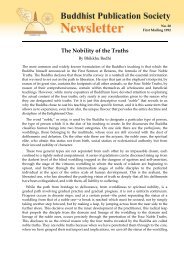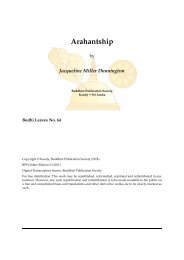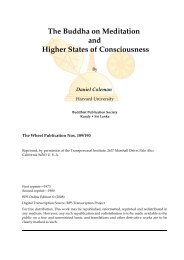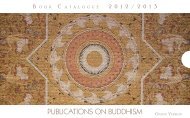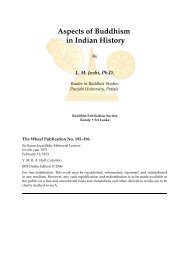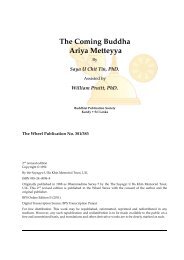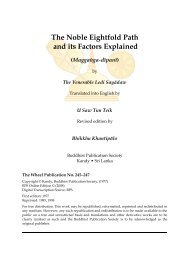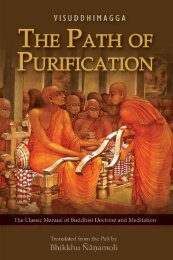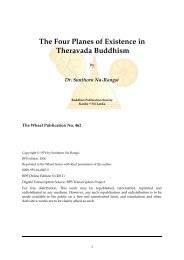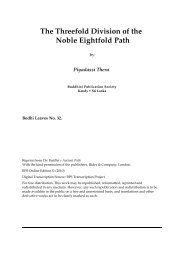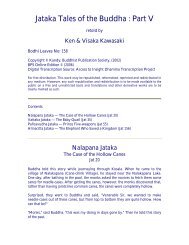Buddhism and Comparative Religion and Other Essays - Buddhist ...
Buddhism and Comparative Religion and Other Essays - Buddhist ...
Buddhism and Comparative Religion and Other Essays - Buddhist ...
You also want an ePaper? Increase the reach of your titles
YUMPU automatically turns print PDFs into web optimized ePapers that Google loves.
emerges from it, just as the fire of the second part of the night is the uninterrupted continuationof the fire that burnt during the first part of it. It is not our task here to deal with the differenttheories of the antarābhava, 2 etc. which have been devised to explain or to prove this theory. Inthis connection it is sufficient for our purpose to establish the fact that <strong>Buddhism</strong> is in fullaccordance with many other religions in the supposition of a life after death in which all acts arerequited. The only difference between <strong>Buddhism</strong> <strong>and</strong> other Indian religions consists in this that<strong>Buddhism</strong> gives a different philosophical interpretation. In practice it is in complete harmonywith all systems that accept metempsychosis. Instead of the theory of an immutable permanentsoul which forms the nucleus of the individual A in this existence <strong>and</strong> of the individual B in thenext existence, it offers a different view: every individual is a stream of evanescent dharmas(physical <strong>and</strong> mental factors of existence) arising in functional interdependence. Every newindividual existence is the flowing on of this stream.This doctrine of reincarnation without the adoption of the belief in a persistent soul-substancehas always puzzled scholars, <strong>and</strong> it has been called a logical impossibility because it denies theidentity of the man who has done an action <strong>and</strong> of another man on whom it is rewarded. But intruth it has quite the same metaphysical value as the theory of a w<strong>and</strong>ering permanent soul.Professor T. R. V. Murti 3 rightly says: “How does the acceptance of the ātman, the unchangingpermanent entity, explain kamma, rebirth, memory or personal identity more plausibly? As thepermanent soul is of one immutable nature, it cannot have different volitions when differentcircumstances call for different actions. … A changing ātman (soul) is a contradiction in terms.No ātman-view has accepted or can accept a changing self; for once we accept change of theātman, we have no valid argument to confine this change to definite periods i.e. it remainsunchanged for an appreciable stretch of time <strong>and</strong> then changes. This would mean two differentātmans. Nor can we admit that one part of the ātman changes while the other part is permanent.If the changing part does belong to the ātman as integrally as the other part, then we would behaving a supposedly unitary entity, which has two mutually opposed characteristics. This doesviolence to our conception of an entity.”When the Buddha replaced the theory of a permanent soul substance with the theory of a“mind-continuum,” he tried to avoid the difficulties inherent in the doctrine of ātman. That histheory also conceals knotty points is evident. For, no sufficient philosophical arguments can beadduced for things which transcend the human faculty to demonstrate rationally matters thatare not accessible to our limited comprehension. The belief that there is no continuation of anysort of life after the death of an individual is also not strictly demonstrable; for the theory of amatter out of which everything is produced is as equally an outcome of speculation <strong>and</strong> of acertain “Weltanschauung” as the different hypotheses concerning the soul or the mindcontinuum.Stranger still, it appears to most observers that <strong>Buddhism</strong> denies the existence of a creator<strong>and</strong> ruler of the world because for many religious minds, especially in the Occident, religion issynonymous with the belief in God. For this reason many theologians have said, “<strong>Buddhism</strong> is aphilosophical or ethical system but no religion.” This view, however, is a very superficialsubterfuge. For, judging from its outward appearances as well as from its inner attitudes,<strong>Buddhism</strong> exhibits all the marks observed in other religions. It has places of worship, rites, <strong>and</strong>monasteries, <strong>and</strong> with its adherents it calls forth purely religious feelings of devotion, piety,tranquillity of mind, etc. It has its legends, relates wonders, tells of visions of heaven <strong>and</strong> hell,etc. It even acknowledges a great number of celestial beings who, although they have no eternallife, exist for centuries <strong>and</strong> may give their worshippers worldly comfort <strong>and</strong> happiness. All thismakes it evident that to <strong>Buddhism</strong> the appellation religion cannot be denied. This shows that2Intermediate existence between two lives; a conception developed in later schools of <strong>Buddhism</strong>.3T. R. V. Murti, The Central Philosophy of <strong>Buddhism</strong>, London 1955, p. 32.4




